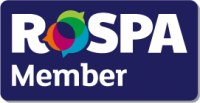Marine Mooring System Services
TTI undertake preliminary and detailed design of all manner of mooring systems, for example:
- Analysis and design of wishbone moorings for supply boats
- Development of analysis tools for mooring submerged vessels
- Development of design methods for a hybrid deepwater mooring system
- Detailed design of tethers for riser mid-water support buoy.
- Special mooring systems with minimal acoustic signature.
- Design of a synthetic rope taut mooring system for a research facility.
- Design of synthetic moorings for inshore / offshore Aquaculture pens.
Mooring Hawsers
TTI offers specialist services to operators of Single Point Mooring terminals with particular emphasis on optimisation of mooring hawser replacement strategies.
- Mooring system design / re-design
- Hawser selection and specification
- Establishment of hawser retirement criteria
- Fatigue life and residual strength prediction
- Hawser failure investigation and analysis
- Inspection and testing of hawsers
Deep Water Moorings
The engineering of vessel moorings in very deep waters is challenging and requires innovative solutions. Novel arrangements and synthetic materials characterise deepwater mooring solutions and TTI are at the forefront of this technology having lead or contributed to most of the recent collaborative research projects in this area.
- Fibre Tethers 2000.
- DEEPSTAR Fibre Rope Mooring Trial.
- Engineer’s Design Guide for Deepwater Fibre Moorings.
- Large Scale Testing of Fibre Mooring Ropes
- Durability of Polyester Mooring Ropes
There are two particular concepts, which adopted separately or combined, have proved to offer considerable scope for mooring in very deep waters:
- Taut Leg Moorings
- Synthetic Rope Moorings
- Taut Leg Moorings
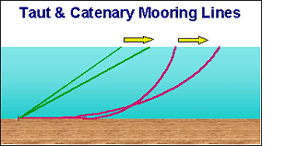
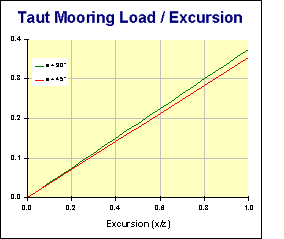
.gif)
TTI defines a taut leg as one where the line rises from the anchor under normal pretension, so there is no grounded line to lift off the seabed as line tension increases. Because of this, taut moorings work in a fundamentally different way to catenary moorings, their compliance deriving mainly from the elastic stretch of the lines, whereas a catenary mooring derives its compliance from the change in suspended line weight.
A taut mooring leg will usually have an angle of between 30 and 45 degrees to horizontal at the vessel (determined from design considerations) and will exhibit fairly linear load-excursion characteristics which are related to this angle and the stiffness of the line.
Because taut moorings have a much more linear stiffness than the progressively stiffening catenary systems, offsets under mean load can be better controlled and vessel motions do not induce such a high proportion of total line tensions.
A further advantage is the better load sharing between adjacent lines than is typical of a catenary array, so improving overall efficiency of the system.
The taut mooring also overcomes another limitation of deepwater catenarys by having much shorter lines. Scopes of under 2, compared to 5 or more with catenary systems, save material and give a more compact seabed footprint.
The lines of a taut mooring need to have sufficient elasticity to absorb the vessel wave motions without over loading. Where motions are low either because of benign wave environment (eg. West Africa or Brazil) or because of the vessel characteristics, (as a SPAR for example), wire ropes may be appropriate, particularly in deep water where there is the line length to develop enough stretch. However, the weight of steel mooring wires in very deep waters may become too much of a penalty on the vessel payload and, furthermore, strength utilisation is reduced as more of the line tension capacity will be used in keeping the wire taut.Synthetic Rope Moorings
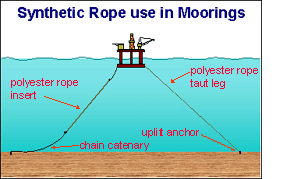
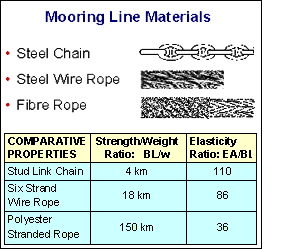
Synthetic fibre ropes offer a potential solution to the weight problems of using steel mooring lines in deepwater as they have a very low weight in water.
Also, compared to steel, there are a vary large number of synthetic fibre material compositions with a wide range of material properties. A synthetic rope can therefore be designed to have properties that match the mooring requirements.
Materials that have potential for mooring line application include:
- Nylon
- Polyester
- Aramid (Twaron, Technora and Kevlar)
- Liquid Crystal Polymer
- High Modulus Polyethylene (HMPE)
Yarns of these synthetic materials may be built into ropes using a number of constructions, some of which are suited to particular fibres.
Some of the issues which affect choice of yarn material and the rope construction are:
- Load-extension behaviour
- Internal heating
- Durability & fatigue endurance
- Termination & end fittings
- Wear & abrasion
- Handling & installation
Synthetic ropes can be used as a lightweight insert in a catenary mooring (usually having a chain catenary segment touching down on the seabed). However, their real potential lies in taut moorings where ropes combining low weight and low elastic modulus with good durability characteristics, will enable efficient mooring systems to be designed for a whole range of water depth and environmental conditions.
The currently favoured synthetic material is polyester for reasons of cost and good fatigue endurance. Polyester has also been used in rope constructions for several years, and the issues of manufacture and end termination for large rope sizes have been satisfactorily resolved. Polyester ropes also have elasticity in the range most suitable for taut mooring of vessels with typical wave motions in very deep and ultra deep water depths up to around 1500 metres (5000 feet).
Optimoor
TTI have developed an advanced computer program Optimoor for analysing the complex behaviour of moored vessels under any environmental conditions. The software enables rapid assessment of moorings to OCIMF requirements and is licensed to port operators worldwide. Both quayside and offshore moorings are handled by Optimoor.
Marine Mooring Systems Design
YOU ARE IN SERVICES
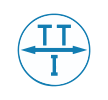
/NQA-ISO-9001-Logo-UKAS.jpg)
